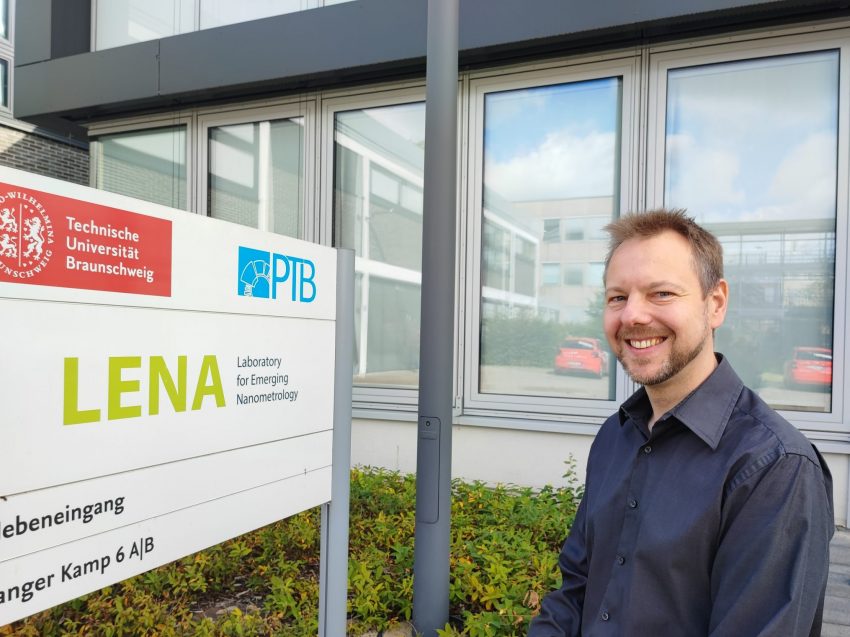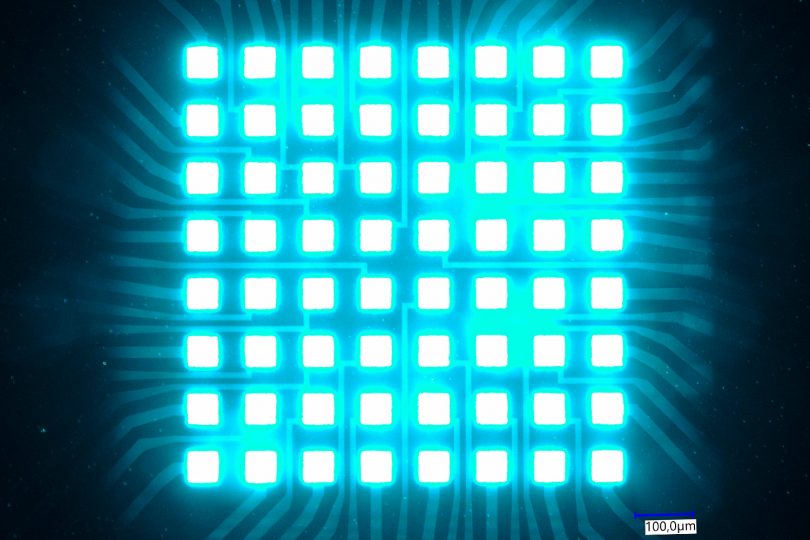Artificial intelligence made of light Professor Christian Werner on his cooperation with LENA
For humans, driving a car in an unfamiliar environment is a comparatively simple exercise. For a computer, on the other hand, this task is extremely demanding and requires a lot of energy. Together, Professor Christian Werner from the OST Eastern Switzerland University of Applied Sciences and Professor Andreas Waag from the TU Braunschweig want to take a completely new approach to make computers more intelligent and less energy-hungry: With a neuron network of microscopic LEDs. For this, Werner has now become an associate member of the LENA research centre.

Professor Christian Werner at the LENA research centre. Picture credits: Laurenz Kötter/TU Braunschweig
Mr Werner, you are a professor for Embedded Software Engineering at the OST in Rapperswil. What exactly is your focus in this field?
I teach and research at the ICOM Institute for Communication Systems, making sure that our students are responsible and competent with current design and programming techniques for embedded software. Embedded software includes computer programmes that do not run on smartphones, PCs or servers, but on sometimes miniscule processors integrated into everyday objects or machines, such as a navigation system in a car, a surveillance camera, a smartwatch or a bicycle computer. Embedded software ensures that these systems behave sensibly and, in the best case, “intelligently”. Methods from the field of artificial intelligence (AI) are playing an increasingly important role in this. An important part of my work aims to curb the energy hunger of modern AI systems. This will allow them to get by with a scarce supply of energy in the future – for example, in smaller battery-powered devices. Accordingly, my research focus is on making the world safer, more energy-efficient and smarter on a small scale.
You are officially accepted as an associate member of the Laboratory for Emerging Nanometrology, the LENA at TU Braunschweig. What leads you there?
With my topics, I have actually had a connection to TU Braunschweig for a long time. Since 2018, I have been teaching as a private lecturer at the Institute for Operating Systems and Computer Networks in computer science. What brings me to LENA is, in short, my interest in completely new types of computers. At the moment, almost all computers use the same basic design, the so-called Von Neumann architecture. This is no coincidence, since these systems can be universally programmed and thus used. However, this architecture is increasingly reaching its limits, especially in terms of energy efficiency. Especially in the field of artificial intelligence, we need a disproportionate amount of energy to “teach” increasingly powerful AI systems.
At LENA, I am now working together with Professor Andreas Waag’s research group on a new type of system architecture that is inspired by biological systems. The buzzword here is “neuromorphic computing”. If you try to emulate a model of the brain on classical digital computers, you quickly come up against limits. Instead, we are trying to use LED technology, which is strong in Braunschweig, for information processing based on a biological model instead of conventional digital computers.
So a computer made of microscopic lights? How does this new architecture work?
Basically as an image of the neuronal structure of biological brains: just as countless neurons send out their signals in parallel in our heads, micro-LEDs send out their light signals in criss-cross fashion in our system. Similar to the brain, we are also leaving the area where we can distinguish between hardware and software. The new computer architecture is therefore not programmed in the traditional sense, but has to go through a learning process to solve certain problems.
However, there is still a very long way to go before we have an “artificial brain” on this technological basis that can be used for concrete applications. Although we have already demonstrated the basic functionality of our technology in laboratory experiments, this only concerns the basic functionality of individual neurons. Further research must show how networks of such neurons behave and which learning methods can be used to solve specific tasks.
As a professor at a university of applied sciences, I bring an eye for applications to the project. In the end, our new system architecture should offer added value. I am very grateful to OST for providing me with the time to do research for this project.
What could the future of this new alliance look like?
With LENA, we definitely have a great starting point for this. It is designed to be open and cross-disciplinary. There is simply a willingness to tread completely new paths and not just work out the details of what is technologically possible today. This also applies to teaching, where we can jointly offer internships and theses at LENA. Furthermore, I am looking forward to making new contacts at LENA. As a research centre, it is currently in the midst of numerous exciting large networks such as Quantum Valley Lower Saxony, where neuromorphic computing is also a topic.
If I think even further into the future, our research could provide an important building block for making the transition from the digital computers in use today to associating and ultimately thinking machines. But there is still a long way to go until then.

